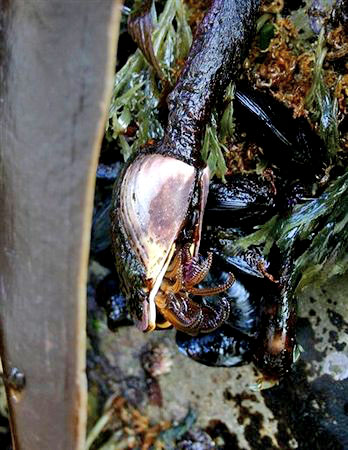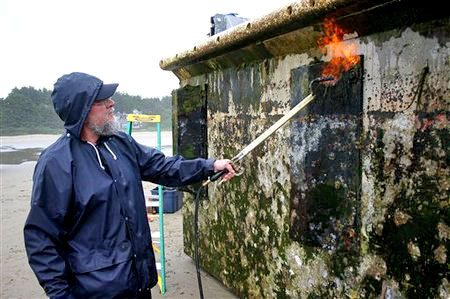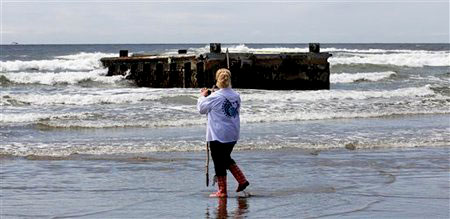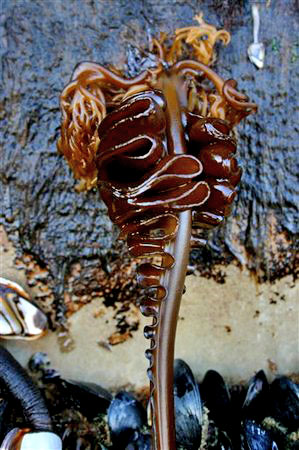|

by Jeff Barnard
Jun 9, 2012
from
APNews Website

This June 7, 2012
photo provided by the Oregon Park and Recreation Department
shows an exotic
mussel attached to a dock float that washed up on Agate Beach near
Newport, Ore.
Scientists are
worried that other debris from the 2011 tsunami in Japan
could represent a new
way for invasive species to reach American shores.
(AP Photo/Oregon
Parks and Recreation Department, ho)
When a floating dock the size of a
boxcar washed up on a sandy beach in Oregon, beachcombers got
excited because it was the largest piece of debris from last year's
tsunami in Japan to show up on the West Coast.
But scientists worried it represented a whole new way for invasive
species of seaweed, crabs and other marine organisms to break the
earth's natural barriers and further muck up the West Coast's marine
environments.
And more invasive species could be
hitching rides on tsunami debris expected to arrive in the weeks and
months to come.
"We know extinctions occur with
invasions," said John Chapman, assistant professor of fisheries
and invasive species specialist at Oregon State University's
Hatfield Marine Science Center.
"This is like arrows shot into the
dark. Some of them could hit a mark."
Though the global economy has
accelerated the process in recent decades by the sheer volume of
ships, most from Asia, entering West Coast ports, the marine
invasion has been in full swing since 1869, when the
transcontinental railroad brought the first shipment of East Coast
oysters packed in seaweed and mud to San Francisco, said Andrew
Cohen, director of the Center for Research on Aquatic Bioinvasions in Richmond, Calif.
For nearly a century before then, ships
sailing up the coast carried barnacles and seaweeds.

This June 7, 2012
photo provided by the Oregon Department of Parks and Recreation
shows an unidentified
person sterilizing the side of a dock float torn loose
from a Japanese
fishing port by the 2011 tsunami that washed up on Agate Beach near
Newport, Ore.
Scientists say they
don't now yet how much the tons of tsunami debris
may add to the
invasive species problem on the West Coast.
(AP Photo/Oregon
Department of Parks and Recreation)
Now, hotspots like San Francisco Bay amount to a "global zoo" of
invasive species and perhaps 500 plants and animals from foreign
shores have established in U.S. marine waters, said James Carlton,
professor of marine sciences at Williams College.
They come mostly from ship hulls and the
water ships take on as ballast, but also get dumped into bays from
home aquariums.
The costs quickly mount into the untold billions of dollars.
-
Mitten
crabs from China eat baby Dungeness crabs that are one of the
region's top commercial fisheries.
-
Spartina, a ropey seaweed from
Europe, chokes commercial oyster beds.
-
Shellfish plug the cooling
water intakes of power plants.
-
Kelps and tiny shrimp-like creatures
change the food web that fish, marine mammals and even humans depend
on.
A 2004 study in the scientific journal Ecological Economics
estimated 400 threatened and endangered species in the U.S. are
facing extinction because of pressures from invasive species.
It is too early for scientists to know how much Japanese tsunami
debris may add to the invasive species already here.
"It may only introduce one thing,"
said Cohen of the Aquatic Bioinvasions research center.
"But if that thing turns out to be a
big problem, we would rather it not happen. There could be an
economic impact, an ecological impact, or even a human health
impact."

This June 6, 2012
photo shows Sue Odierno, of Salishan, Ore.,
looking at the
massive dock from Japan
that washed ashore on
Agate Beach near Newport, Ore.
Scientists are
concerned that tsunami debris like this could be
a new avenue for
invasive species arriving on the West Coast
(AP Photo/Rick Bowmer)
The dock, torn loose from a fishing port on the northern tip of
Japan, was covered with 1.5 tons of seaweed, mussels, barnacles and
even a few starfish. Volunteers scraped it all off, buried it above
the high water line, and sterilized the top and sides of the dock
with torches.
But there was no telling whether they might already have released
spores or larvae that could establish a foothold in a bay or estuary
as it floated along the coast, said Carlton.
"That's the 'Johnny Clamseed'
approach," he said, referring to Johnny Appleseed, the pioneer
apple tree planter of the early 19th century. "While
that is theoretical, we don't actually know if that kind of
thing happens."
One thing they know is that the bigger
the debris, the more likely it has something on it.
Chapman estimated there were hundreds of millions of individual
living organisms on the dock when it washed up on Agate Beach
outside Newport, Ore.

This June 7, 2012
photo provided by the Oregon Department of Parks and Recreation
shows a seaweed from
Japan commonly known as wakame on a dock
that floated up on
Agate Beach near Newport, Ore.,
after being torn
loose from a fishiing port in Japan by the 2011 tsunami.
Scientists are
concerned that some of the tsunami debris
coming to the West
Coast and Alaska could spread invasive species like this seaweed.
(AP Photo/Oregon
Parks and Recreation Department, ho)
But even a small plastic float that
washed up on a beach in Alaska carried a live oyster, said Mandy
Lindeberg, research scientist at the NOAA Fisheries Auke Bay
Laboratories in Juneau, Alaska.
The smaller bits of plastic expected to make up most of the tsunami
debris won't have anything except species they picked up at sea,
said Carlton.
On the dock, about half the plant species already exist on the West
Coast, said Gayle Hansen, a research marine taxonomist at Oregon
State University, who has spent hours with her eye scrunched up
against a microscope examining samples from the dock.
Among the exotic seaweeds was one known as
wakame, which has become
a nuisance around the world, but is not yet found in Oregon, she
said.
Whether hitchhiking species will survive here depends on randomness,
she said. Seaweeds probably would not have survived to reproduce in
the crashing surf at Agate Beach. It's the wrong kind of
environment.
But if they had floated into Yaquina
Bay, very similar to their home waters in Japan, they could grow and
reproduce.
Lindeberg said,
"The only defense for invasive
species is early detection. Just like cancer."
While monitoring is relatively cheap,
say $30,000 to watch nearby waters for species from the dock, trying
to stop an established invasion is expensive. California spent $7
million trying to eradicate a seaweed, she said.
She said she hoped there would be funding for monitoring tsunami
invasive species.
James Morris, a marine ecologist and invasive species
specialist at the NOAA National Centers for Coastal Ocean Science,
in Beaufort, N.C., said the idea a natural disaster like the tsunami
could introduce a new avenue for invasive species is intriguing.
"It goes to show you that when it
comes to invasive species, there are some things you can work to
regulate and control," he said. "And there are issues like this
that come up that open up a whole different realm of
possibilities."
|




